11 Types of Blackbirds in Nebraska (With Pictures)
-

- Last updated:
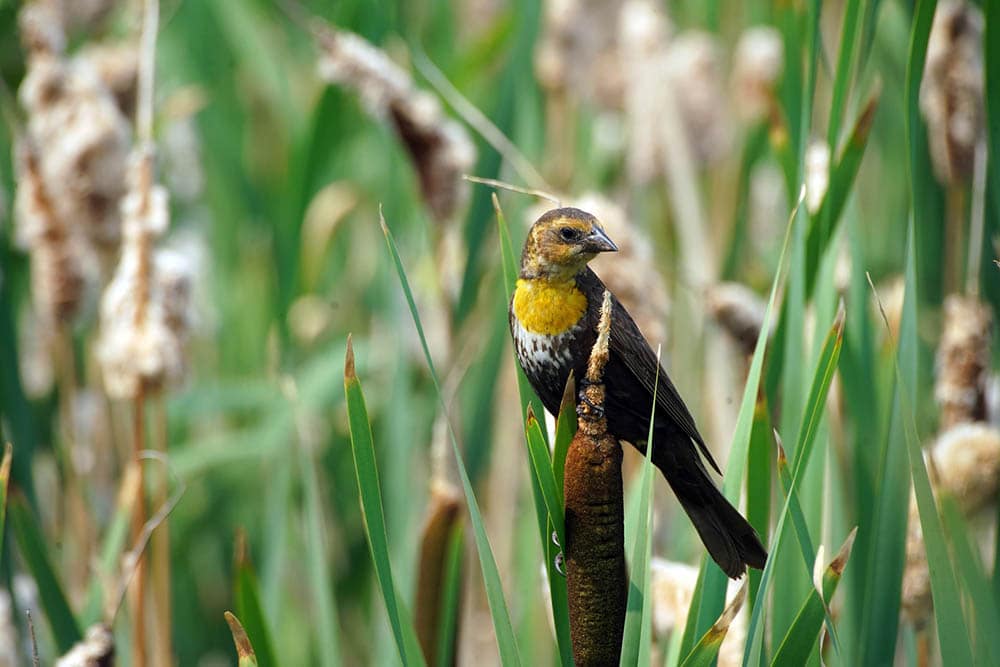
Blackbirds consist of grackles, orioles, cowbirds, and All-New Word blackbirds. These birds are voracious feeders and are known for bullying smaller species. As such, they’re considered agricultural pests, a reputation that has sadly led to decreased numbers.
Nebraska boasts many types of blackbirds. Some blackbird varieties are considered accidental and rare, while some are considered vulnerable or near-threatened.
The following are some of the most common blackbirds in Nebraska and the best time to see them.
The 11 Types of Blackbirds in Nebraska
1. Common Grackle

| Scientific Name: | Quiscalus quiscula |
| Length: | 11–13 inches |
| Weight: | 2.5–5 ounces |
| Wingspan: | 14–18 inches |
Although it’s considered near threatened, the common grackle is Nebraska’s most common and frequently spotted blackbird. This species spends the breeding season in the state before migrating south at the onset of cold weather. However, some birds remain.
The males and females are glossy black, although the males’ gloss is more pronounced, topped by an iridescent blue head. These birds are tall and have longer tails than typical blackbirds and gather in trees where they make noisy squeaks, whistles, and croaks.
The common grackle appears on the IUCN red list as near threatened since its population has declined by more than 50% since the 70s. These birds prefer marshes, open woodlands, fields, or parks and will gather in their millions to feed on crops, especially corn.
2. European Starling
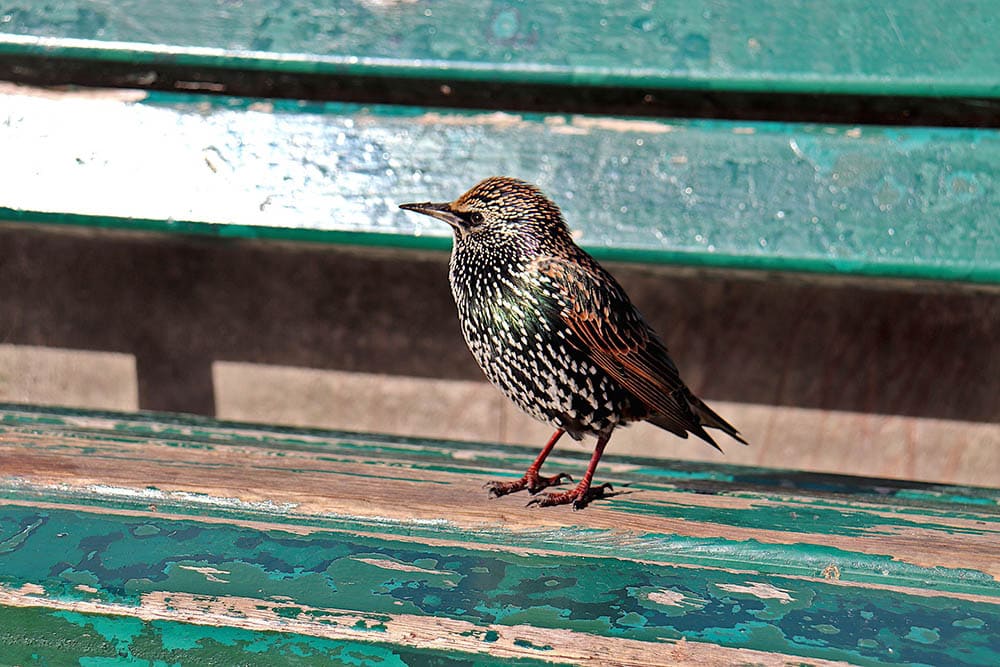
| Scientific Name: | Sturnus vulgaris |
| Length: | 8–9 inches |
| Weight: | 2–3 ounces |
| Wingspan: | 12–15 inches |
While not native to the American continent, the European starling is one of Nebraska’s most spotted blackbirds. You can see this bird throughout the state all year round as it doesn’t migrate.
Unfortunately, it is also considered an agricultural pest.
European starlings fly in flocky formations and make lots of noise, and you’ll spot them across fields or flying on the tops of trees. They call with charters, warbles, or whistles and will gather in thousands to socialize or eat various insects, fruit, seeds, and grain.
Starlings are almost the size of an American robin and have shiny black plumage with short tails. In winter, the bird’s coats lose glossiness, developing white spots on their bodies while their beaks turn darker.
3. Red-winged Blackbird
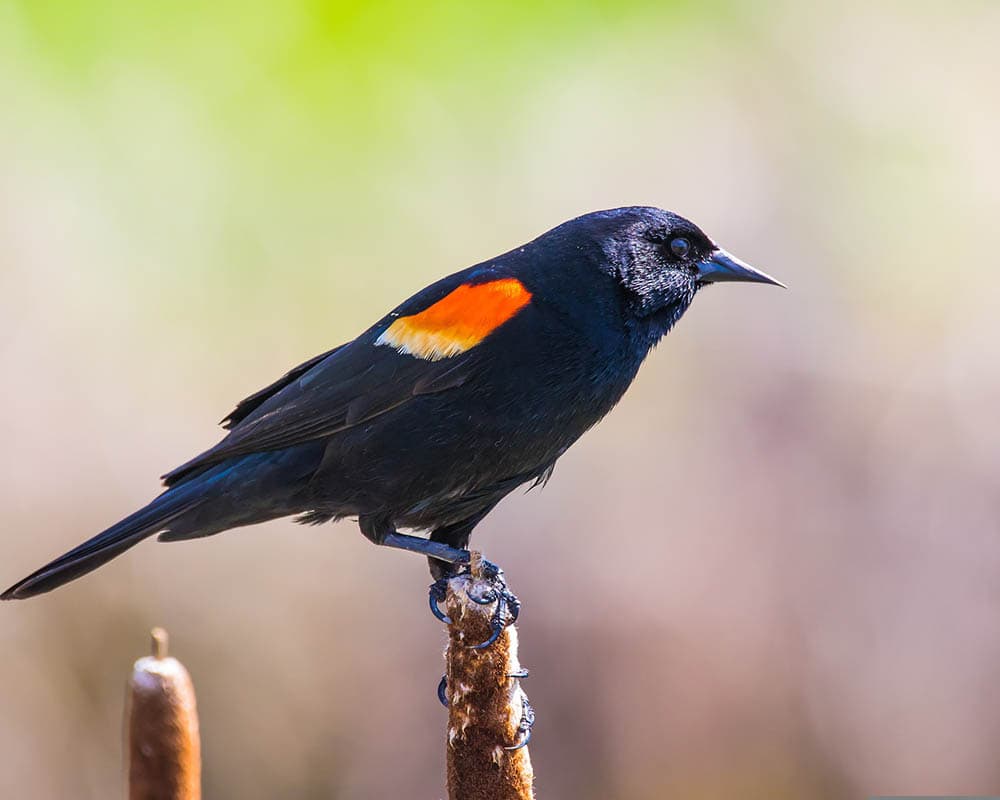
| Scientific Name: | Agelaius phoeniceus |
| Length: | 7–9 inches |
| Weight: | 2–3 ounces |
| Wingspan: | 12–15 inches |
Besides the European starling and common grackles, red-winged blackbirds fall next in line as the most spotted species in Nebraska. The males have a characteristic all-black coat except for reddish-orange and yellow patches on their wings, while females are heavily streaked brown.
The red-winged blackbirds spend lots of their time in wetlands and marshes, especially during their breeding season. When they’re not nesting, you’ll see them in farm fields, pastures, and grasslands, where they forage for weedy seeds.
Red-winged blackbirds prefer flocking on sedges, bulrushes, cattails, and other dense vegetation. It’s also common to see this species mingling with other birds, especially cowbirds, starlings, and grackles.
4. Western Meadowlark

| Scientific Name: | Sturnella neglecta |
| Length: | 6–10 inches |
| Weight: | 3–4 ounces |
| Wingspan: | 16 inches |
Although the western meadowlark appears mostly in summer, you can still see a small population during winter in Nebraska. It’s a bird known for being musical and having a bright yellow belly and V-shaped black bands across the breast.
In winter, the yellow on their breasts fades to gray, but the white feathering and upper body browns remain. These birds don’t prefer large flocks or dense vegetation, and you’ll see them in grasslands, fields, and meadows foraging on the ground.
Meadowlarks frequent Nebraska between March and October, but those that breed in the Midwestern and western regions remain all year. Their diet consists of seeds, grain, and insects.
5. Baltimore Oriole
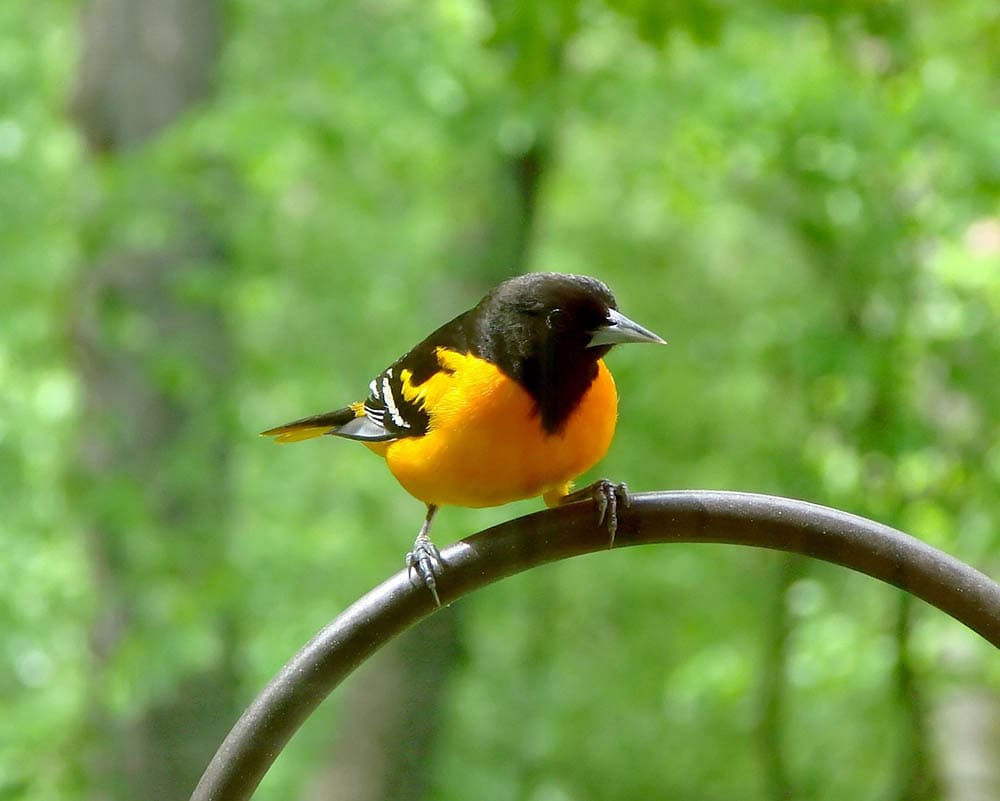
| Scientific Name: | Icterus galbula |
| Length: | 6.7–7.5 inches |
| Weight: | 1–1.4 ounces |
| Wingspan: | 9–11.8 inches |
With a 32% appearance on the summer checklist for birdwatchers in Nebraska, the Baltimore oriole arrives in early April and stays until December. The best months to spot these blackbirds, a colorful herald of springtime, are May to September.
The male Baltimore orioles stand out in black and bright orange plumage with white bars on the wings. While females lack their mate’s black back and hood, they feature duller colors of brownish-yellow undersides and gray-brownish wings.
Baltimore oriole blackbirds are slender, being about the size of an American robin. They’re fond of riverbanks, forest edges, and high open woodland where they forage for fruit, seeds, and insects.
6. Brown-headed Cowbird
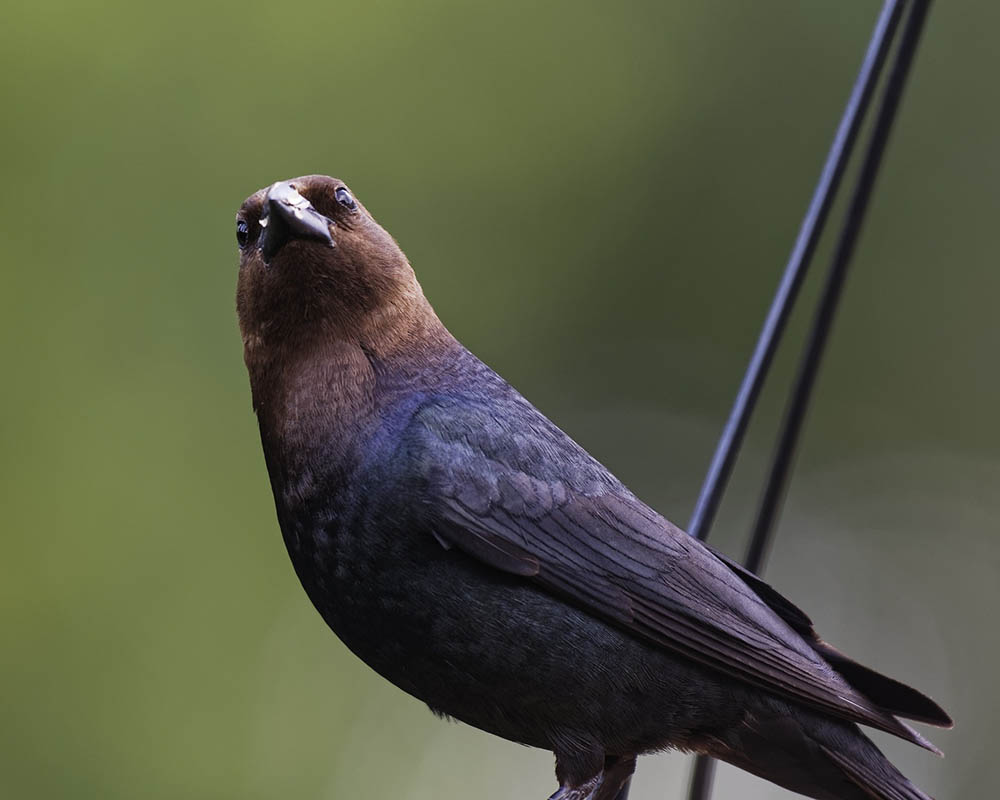
| Scientific Name: | Molothrus ater |
| Length: | 7.6–8.7 inches |
| Weight: | 1.3–1.8 ounces |
| Wingspan: | 14 inches |
While some birds are all-year residents in Nebraska, brown-headed cowbirds appear mostly in the summer during their breeding season. The smaller females have gray-brown plumage, while the males have brown heads, black bodies, and short tails.
The brown-headed cowbird is stocky and has a thick beak. You won’t find these birds in the woods as they prefer fields and grasslands, seeking insects, grass, and weed seeds.
Brown-headed cowbirds are ground foragers and trail behind grazing animals, picking up food that’s kicked up. These birds are brood parasites and will lay their eggs in the nest of anything from a meadowlark to an eaglet.
7. Orchard Oriole
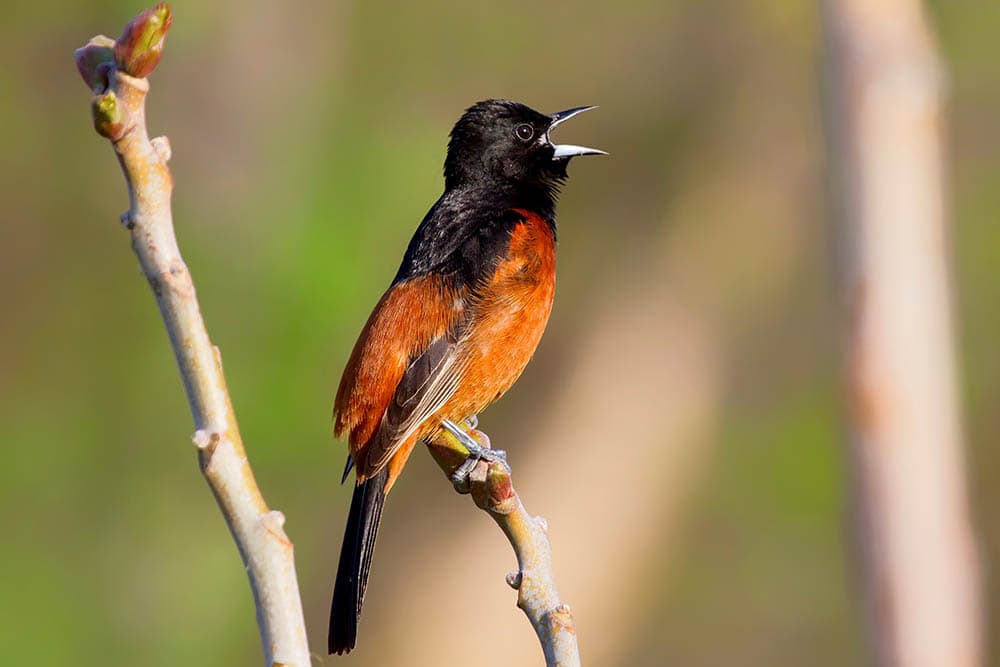
| Scientific Name: | Icterus spurius |
| Length: | 5–7 inches |
| Weight: | 0.6–1 ounce |
| Wingspan: | 9.8 inches |
From May to September, you’ll see a fair amount of Orchard Orioles in Nebraska. Males have bold coloring, black backs and heads, and reddish underbellies.
Female orchard orioles have a yellow-green plumage that’s dark on the back but pale underneath. Their wings are darker than their male counterparts, and they spot white wing bars.
Orchard orioles prefer riverbanks, farmland, shrubs, and open woodland. They nest on trees where they weave pouch-like nests hanging from twigs. The species is prevalent in Nebraska during the warmer months before migrating south for winter.
8. Yellow-headed Blackbird
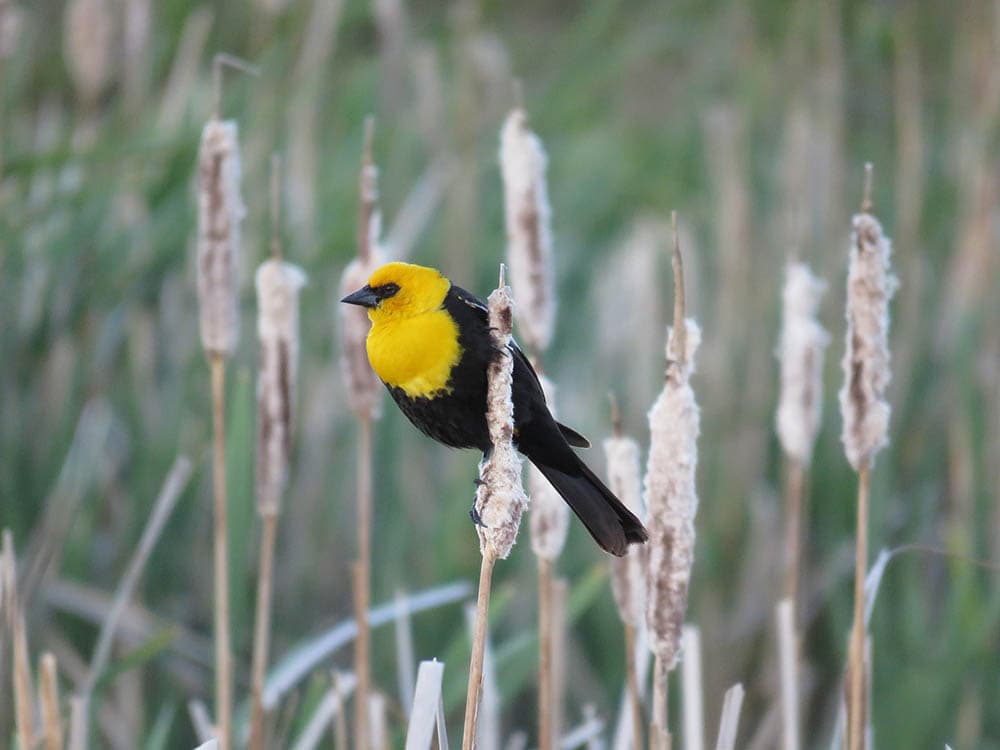
| Scientific Name: | Xanthocephalus xanthocephalus |
| Length: | 8.3–10.2 inches |
| Weight: | 1.6–3.5 ounces |
| Wingspan: | 16–17 inches |
Although not commonly spotted in Nebraska, yellow-headed blackbirds come to the state to breed between March and October. They’re striking birds, to say the least. Males have bright yellow heads and breasts against a black body and white wing patches.
Larger than red-winged blackbirds, female yellow-headed blackbirds have brown plumage with a less brilliant yellow on their head. Amid its brownish coat, this bird has touches of white and yellowish streaks down its breast.
You’ll find yellow-headed blackbirds in communal flocks of other songbird species, foraging in agricultural areas and fields. They make their nests in wetlands, weaving stems attached to reeds and cattails together over the water.
9. Bobolink

| Scientific Name: | Dolichonyx oryzivorus |
| Length: | 5.9–8.3 inches |
| Weight: | 1–2 ounces |
| Wingspan: | 10.6 inches |
Bobolinks arrive in Nebraska in April, staying until October, although the best time to spot them is between May and August. They’re easy to identify, especially the males with black bellies, white backs, and yellow patches on their heads that appear hair-like.
In comparison, the female bobolink and non-breeding males are plain, particularly in their winter plumage of brown streaks. You’ll further identify them by the stripes on their crowns and dark eye lines.
You’ll spot bobolinks in open grassland when they’re breeding or on top of trees foraging for insects and seeds. Although they number more than eight million, their populations have declined by over 60% since the late 90s.
10. Great-tailed Grackle

| Scientific Name: | Quiscalus mexicanus |
| Length: | 15–18 inches |
| Weight: | 3.7–6.7 ounces |
| Wingspan: | 18.9–22.8 inches |
The Great-tailed Grackle prefers urban and agricultural areas where humans are in Nebraska. They are considered naturally occurring residents of this state, and you can spot them all year round.
These long, slender blackbirds have piercing, iridescent eyes, long legs, and impressive tapered tails. The females have thinner tails and spot a dark brown plumage.
Great-tailed grackles feed on seeds, grains, fruit, and insects, including bees, spiders, beetles, and slugs. They also prey on small mammals, nestlings, and eggs.
11. Brewer’s Blackbird

| Scientific Name: | Euphagus cyanocephalus |
| Length: | 7.9–9.8 inches |
| Weight: | 1.8–3 ounces |
| Wingspan: | 14.6 inches |
This medium-sized bird has glossy black plumage, with males having green and purple iridescent coloring on their bodies and head.
Female Brewer’s Blackbirds are mostly brown and make their nests in shrubs and trees during the breeding season. The birds thrive in various habitats, including marshes, woodlands, meadows, and coastal regions.
Brewer’s Blackbirds feed on grain, seeds, and insects. You’ll hear them making shrill calls, characterized by clucking songs. Unfortunately, they aren’t very easy to spot.
Conclusion
There’s no doubt that Nebraska is a birding enthusiast’s paradise as it is home to over 450 avian species. The state has tall and short grass prairies, mixed grass prairies, and sandhills that provide perfect breeding grounds for birds. Food is also in abundance in many places.
Blackbirds are prevalent in Nebraska almost all year round, depending on the species. Be sure of the best time to see your preferred species before heading out to avoid disappointment.
Featured Image Credit: gayleenfroese2, Pixabay
Contents


